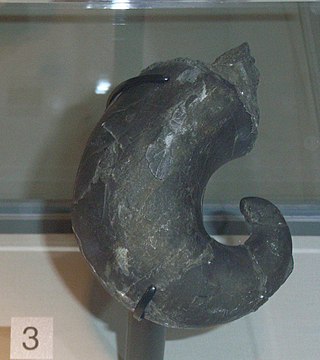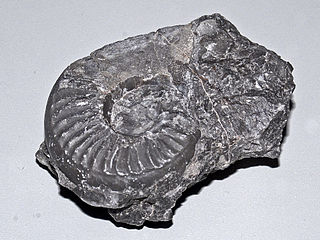
The Nautilida constitute a large and diverse order of generally coiled nautiloid cephalopods that began in the mid Paleozoic and continues to the present with a single family, the Nautilidae which includes two genera, Nautilus and Allonautilus, with six species. All told, between 22 and 34 families and 165 to 184 genera have been recognised, making this the largest order of the subclass Nautiloidea.

The Oncocerida comprise a diverse group of generally small nautiloid cephalopods known from the Middle Ordovician to the Mississippian, in which the connecting rings are thin and siphuncle segments are variably expanded. At present the order consists of some 16 families, a few of which, such as the Oncoceratidae, Brevicoceratidae, and Acleistoceratidae contain a fair number of genera each while others like the Trimeroceratidae and Archiacoceratidae are represented by only two or three.
Permoceras, the sole member of the family Permoceratidae, is a genus of coiled nautiloids with a smooth, compressed involute shell, whorls higher than wide, earlier whorls hidden from view. The venter is rounded as are the ventral and umbilical shoulders, the flanks flattened. The siphuncle is ventrally subcentral. The suture, which is most characteristic, has a deep, narrow pointed ventral lobe and large, asymmetrical pointed lobes on either side.
Endolobus is an extinct genus from the nautiloid order, Nautilida. Nautiloids are a subclass of shelled cephalopods that were once diverse and numerous but are now represented by only a handful of species, including Nautilus. Endolubus is included in the family Koninckioceratidae which is part of the superfamily Tainoceratoidea.
Permonautilus is an extinct genus of nautilids from the Upper Permian of Russia, named and described by Kruglov in 1933. Permonautilus is an involute, globular, spinose member of the Lirocertidae which are included in the Clydonautilaceae. Whorl sections are broad, with a rounded venter. The umbilicus in the middle of the shell is deep, from which spine-like processes extend laterally in the mature portion near the aperture. The siphuncle in Permonautilus is subcentral, the suture, slightly sinuous.
Valhallites is an extinct genus in the nautiloid order Nautilida which includes the living Nautilus found in the tropical western Pacific Ocean. Valhalites belongs to the Koninckioceratidae, a family in the Tainoceratoidea, a nautilid superfamily.
Solenochilus, type genus of the Solenochilidae is an extinct cosmopotilian nautilid from the Lower Pennsylvanian to the Lower Permian with a rapidly expanding, coiled globular shell with few whorls, from which prominent spines extend laterally from the umbilical area at maturity. Solenochilus is derived from the Upper Mississippian Acanthonautilus, principally through evolutionary changes in the siphuncle.
The Clydonautiloidea are a superfamily within the nautiloid order Nautilida characterized by smooth, generally globular, shells with nearly straight sutures, in early forms, but developing highly differentiated sutures in some later forms. Where known, the siphuncle tends to be central to subcentral.

The Trigonoceratoidea are a superfamily within the Nautilida that ranged from the Devonian to the Triassic, thought to have contained the source for the Nautilaceae in which Nautilus is found.
For a further discussion of this group as in use today, see the superfamily Tainocerataceae

Oncoceratidae is a family of nauatiloid cephalopods in the order Oncocerida established by Hyatt, 1884, that range from the Middle Ordovician to the Upper Silurian.

Rutoceratidae is a family of prototypical nautilids, derived probably from either Brevicoceratidae or Acleistoceratidae of the order Oncocerida early in the Devonian. Rutoceratidae comprise a family within the oncocerid superfamily Tainocerataceae They are generally characterized by cyrtoconic and gyroconic shells, commonly with spines, nodes, or frills, although some included genera are almost orthoconic, and a commonly empty, tubular ventral siphuncle.

Grypoceratidae is the longest-lived family of the Trigonoceratoidea, or of the near equivalent Centroceratina; members of the Nautilida from the Upper Paleozoic and Triassic.
The Trigonoceratidae is a family of coiled nautiloid cephalopods that lived during the period from the Early Carboniferous (Mississippian) to the Early Permian.

The Aipoceratoidea are a superfamily within the order Nautilida characterized by rapidly expanding, smooth to ribbed, cyrtoconic to coiled shells with rounded or sometimes dorsally flattened or impressed whorls, nearly straight sutures, and a ventral and marginal siphuncle. Septal necks are orthochoanitic ventrally and orthochoanitic or cyrtochoanitic dorsally.
Aphelaeceras is an extinct genus from the nautilid family Trigonoceratidae which is part of the Trigonocerataceae, that lived during the Mississippian Period in the late Paleozoic.
Liroceratidae is an extinct family of nautilids, shelled marine molluscs, belonging to the Clydonautiloidea, consisting of generally smooth, involute, nautiliconic forms with a small umbilicus. The whorl section is usually depressed and broadly rounded, the suture only slightly sinuous, and the siphuncle usually more or less central.
Ephippioceratidae is a family of clydonatilacean nautilids with shells as in the Liroceratidae but with sutures that have deep ventral and dorsal saddles. This group, which contains two genera, Ephippioceras and Megaglossoceras, has a range from the Mississippian to the Lower Permian.

Tainoceratidae is a family of late Paleozoic and Triassic nautiloids that are a part of the order Nautilida, characterized by large, generally evolute shells with quadrate to rectangular whorl sections. Shells may bear ribs or nodes, or both.
The Rhiphaeoceratidae are a small family of nautilids included in the superfamily Tainoceratoidea that comprises four very similar genera. These genera are characterized by a perforate umbilicus and little more than a single evolute coil. Whorl sections are oval, subquadrate, or subtrapezoidal. Sutures bend forward on the outer rim, forming wide shallow ventral saddles and dip strongly to the rear on the inner rim, forming deep dorsal lobes.






